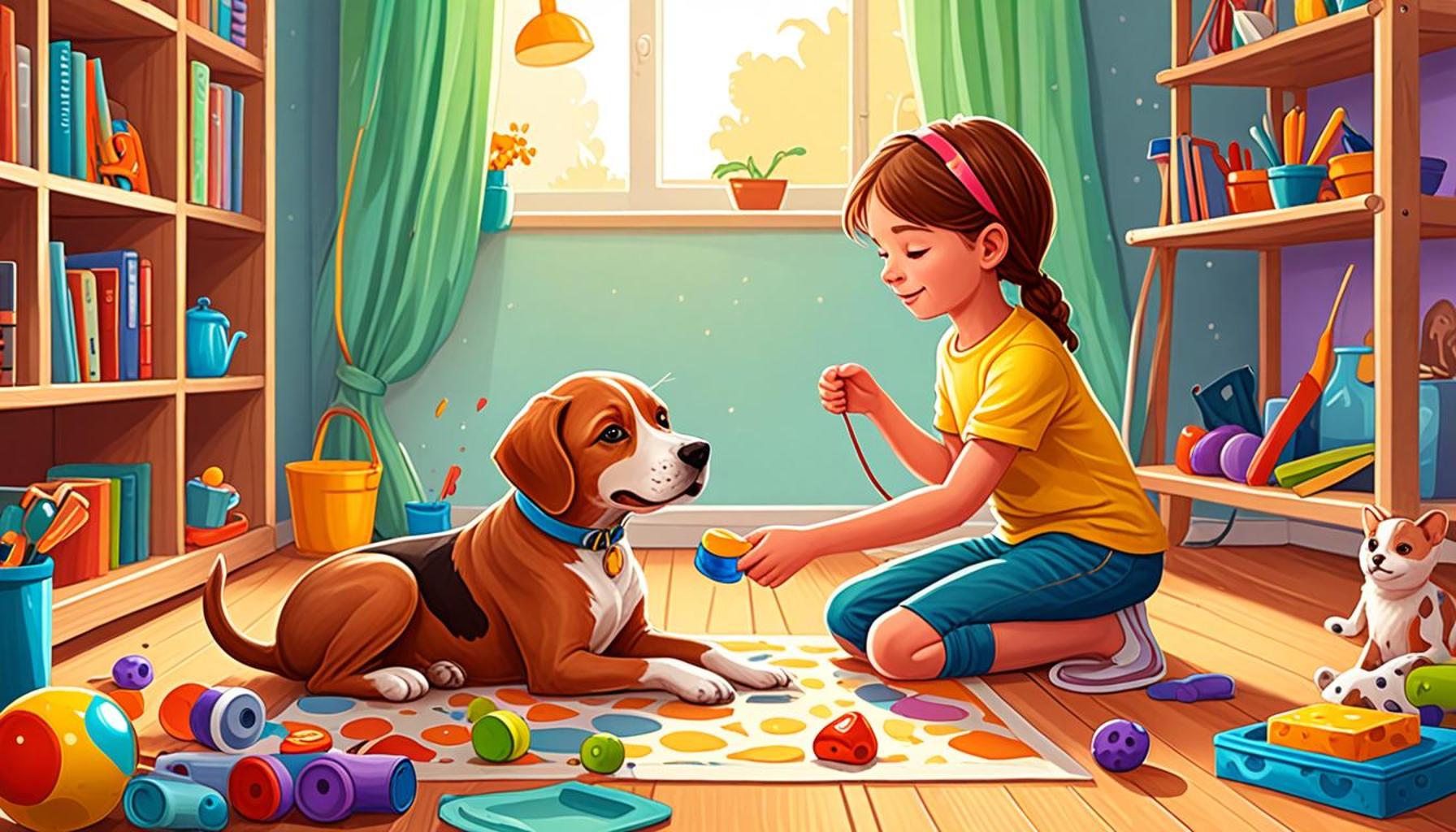Pet Training Strategies for Children at Home

Creating a Harmonious Environment for Pets and Kids
In homes across Nigeria, pets bring joy, companionship, and even a sense of responsibility to children. However, ensuring a positive relationship between kids and their furry friends requires proper training strategies. Understanding how to teach children to train pets at home can foster amazing bonds that will last a lifetime.
Why Training is Essential
- Safety: Proper training is crucial in preventing accidents, such as bites or scratches, and misbehavior. For example, teaching a dog to obey commands like “sit” or “stay” ensures that it remains calm, thus protecting both the child and the pet.
- Responsibility: Training pets teaches children to be accountable for another being’s behavior and needs. By involving kids in the training process, they learn the importance of consistency and care, laying the foundation for responsible pet ownership.
- Bonding: Engaging in training sessions can enhance the bond between children and their pets, leading to lasting friendships. When children participate in training, they not only teach the pet but also learn about trust and communication, deepening their emotional connection.
The excitement of having a pet should be matched with the knowledge of effective training techniques. For families, especially those in urban areas like Lagos or Abuja, understanding local pet care norms is vital. Simple strategies can make a big difference in creating a harmonious household dynamic. For instance, taking time to explore local pet training classes can be beneficial, as these courses often instill effective methods while integrating cultural nuances of pet care in Nigeria.
Effective Pet Training Strategies
- Positive Reinforcement: Rewarding pets for good behavior, such as using treats or praise when a dog performs a trick, encourages them to repeat those actions. This approach not only makes the training enjoyable but also makes the pets eager to learn.
- Consistency: Children should use the same commands consistently to prevent confusion. For example, if a child decides to use “come here” instead of just “come,” it could lead to mixed signals for the pet. Hence, establishing clear, simple commands is key.
- Patience: Training takes time, and children must learn to be patient with their pets. For example, it may take several weeks for a puppy to learn to pee outside. Teaching kids to celebrate small victories, such as the first successful bathroom outing, can foster a positive training environment.
As we explore these strategies further, parents will discover practical tips to empower their children to train pets effectively. The goal is not just achieving obedience but also fostering a nurturing atmosphere that enriches family life. In addition, connecting with local veterinarians or pet trainers can provide invaluable insight and resources tailored to Nigeria’s unique pet ownership culture, enabling families to create a loving and safe home for both pets and children.
RECOMMENDED: Check out this similar article
Practical Approaches to Engage Children in Pet Training
Teaching children how to train pets is more than just a simple task; it is an enriching experience that brings together learning, responsibility, and fun. The strategies in pet training not only teach dogs or cats essential commands but also instills values in children, making them more conscientious individuals. Here, we will explore some practical approaches that can easily be integrated into family life in Nigeria.

Set the Stage for Training
Creating an effective training environment is essential for successful pet training at home. Parents can help children prepare by organizing training sessions in a distraction-free area where pets can focus. For instance, finding a quiet space in the living room or the backyard can minimize interruptions from loud noises or other pets. This strategic location allows both the children and the pets to concentrate on learning.
Interactive Training Sessions
To engage children fully, consider transforming training sessions into interactive games. Incorporating elements of play can make learning fun and exciting. Here are some engaging training activities:
- Treasure Hunt: Hide treats around the house and let pets find them while children cheer them on. This activity reinforces positive behavior and encourages pets to listen and search properly.
- Obstacle Course: Set up simple obstacles using household items such as chairs and pillows. Children can guide their pets through the course, teaching commands like “jump” or “weave.” This not only reinforces commands but also promotes physical activity.
- Follow the Leader: Children can lead their pets around the yard or home, practicing commands like “sit,” “stay,” and “come,” ensuring that they’re following behind. This strengthens the bond as children take the leadership role and pets respond to their commands.
By integrating play into the training routine, children are more likely to stay engaged and motivated. Additionally, these interactions can help develop their leadership skills and build a healthful, trusting relationship with their pets.
Using Visual Aids
Incorporating visual aids can significantly enhance the training experience for children. Visual aids, such as charts with pictures representing different commands like “sit,” “stay,” and “come,” can be posted in the training area. This tool can serve as a reminder for children, making it easier for them to communicate effectively with their pets.
Furthermore, parents can encourage children to keep a training journal. In this journal, children can document their training sessions, noting down what worked well and areas for improvement. This practice not only reinforces their commitment to the pet’s training but also develops their introspection and communication skills.
Ultimately, allowing children to play an active role in the pet training process nurtures a sense of achievement and fulfillment. By creating an engaging, interactive environment filled with fun activities and supportive tools, families can pave the way for an enriching bond between children and their pets, ensuring that both thrive in a harmonious household. In the next section, we will delve into the significance of utilizing technology and local resources to support this training journey.
| Category | Details |
|---|---|
| Positive Reinforcement | This strategy focuses on rewarding desired behaviors with treats or praise, encouraging pets to repeat those behaviors, fostering a positive environment. |
| Bonding through Training | Training sessions create opportunities for children to bond with their pets, promoting trust and companionship, which is essential for both parties. |
| Increased Responsibility | Children learn accountability as they take charge of their pet’s training, instilling a sense of responsibility from a young age. |
| Socialization Skills | Training pets together can enhance children’s social skills, as they learn to share experiences and communicate effectively while working as a team. |
The integration of pet training strategies into home life is valuable not only for pets but also significantly benefits children. Kids are taught vital skills such as communication and patience, which will be essential in their future interactions. By engaging in training activities, children also gain a sense of achievement and confidence, strengthening their emotional development. Moreover, these interactive sessions naturally expose kids to essential behavioral commands, contributing to a well-behaved pet, which allows for a harmonious living environment. Parents observing their children actively involved in pet training will witness a blossoming relationship not just between the child and pet, but also among family members as they share responsibilities and successes together. This enriching journey can inspire families to delve deeper into the world of animal behavior and training, allowing for ongoing learning and fun at home.
LEARN MORE: This related article may interest you
Harnessing Technology and Local Resources for Effective Pet Training
In an age where technology is ubiquitous, its integration into pet training can bring exciting opportunities for families. Particularly in Nigeria, where the digital landscape is rapidly evolving, utilizing apps and online resources can enhance the pet training journey. These tools can support children in learning about pet care while promoting interactive training sessions.
Utilizing Pet Training Apps
There are numerous pet training apps available that provide step-by-step guidance on how to train pets effectively. Apps such as “Pupford” or “Dogo” offer video tutorials, progress tracking, and reward-based training techniques that children can easily follow. By encouraging children to take charge of their pet training through these apps, parents can foster independence and self-discipline in their kids.
Moreover, many apps have sections dedicated to behavioral issues and offer tips tailored to various dog breeds and temperaments. This is especially beneficial for families who might have mixed-breed pets, a common sight in Nigerian households, as they can identify specific characteristics of their pets that need focused training approaches.
Engaging with Local Pet Trainers
While digital tools can be beneficial, local resources should not be overlooked. In Nigeria, pet training schools and community workshops provide excellent learning opportunities. Parents can research local trainers who offer interactive classes where children can participate alongside their pets. These trainers often incorporate fun and educational exercises that enhance children’s understanding of animal behavior.
Working with professionals can also help establish proper handling techniques and address any bad behaviors that may arise. Furthermore, these sessions can serve as a platform for networking and learning from other pet owners, fostering a sense of community among families.
Community Involvement and Training Events
Engaging in community pet events or training days can be another dynamic strategy for children. These events often include pet talent shows, obedience trials, and interactive demonstrations where children can showcase what they have learned and learn from others. In cities like Lagos and Abuja, local shelters and pet stores frequently host such events and can be a fantastic way for children to bond with their pets.
- Local Dog Parks: These parks can be the perfect venue for organized playdates or training sessions that promote socialization. Encourage children to participate in group activities that focus on enhancing their pets’ skills while meeting fellow pet enthusiasts.
- Pet Fairs and Expos: Attending these fairs can be an excellent opportunity for children to learn about different animals and effective training methods. They can interact with various pets and receive firsthand advice from industry professionals.
- Neighborhood Involvement: Establish a neighborhood pet group that meets weekly to share training tips, experiences, and skills. Such gatherings can support teamwork and collaborative learning, reinforcing the community’s values.
By combining technology with local resources, families can create a well-rounded training experience for children and their pets. The exposure to different techniques and the opportunity to learn from various sources can significantly enhance the effectiveness of the training strategies employed at home. This multi-faceted approach not only develops children’s skills but also fosters a deeper connection with their furry friends, ensuring a joyful coexistence within the family unit.
RECOMMENDED: Check out this similar article
Conclusion: Empowering Children Through Pet Training
In conclusion, pet training strategies for children at home can significantly enhance not only the relationship between children and their pets but also cultivate essential life skills. By leveraging modern technology and tapping into local resources, families in Nigeria can implement engaging and effective training methods that resonate with the unique dynamics of their households.
Integrating pet training apps provides children with a platform to take initiative, tracking their progress while gaining insights into their pets’ behaviors. Simultaneously, collaborating with local trainers offers a structured environment that reinforces learning through professional guidance and community engagement. These strategies not only instill a sense of responsibility but also promote social interaction and teamwork among families.
Furthermore, community events and group activities serve as vibrant avenues for children to demonstrate their skills, learn from peers, and celebrate their achievements in a communal setting. They foster a sense of belonging and shared purpose, further enriching the pet training experience.
Ultimately, by focusing on these multi-dimensional approaches, families can transform the pet training journey into a memorable and enriching adventure. Encouraging children to participate actively fosters empathy, patience, and understanding—qualities that are invaluable as they grow. As such, adopting comprehensive pet training strategies not only nurtures well-behaved pets but also shapes well-rounded, responsible children prepared to thrive in a world brimming with possibilities.


